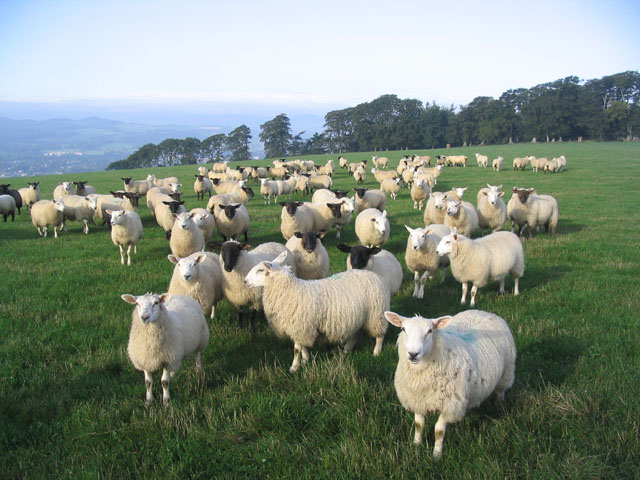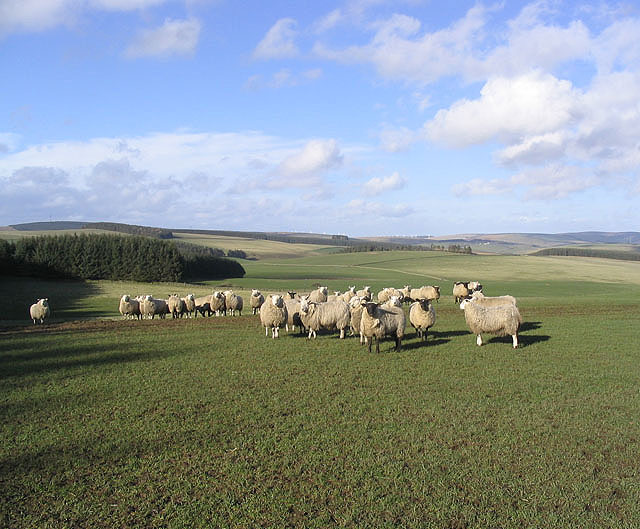.

Beware of sheep. They seem innocent enough to me in this field near Chatto. This old RAC sign is by the minor road from Hownam. An identical sign is by the road to Sourhope, southwest of Attonburn: photo by Walter Baxter, 13 May 2009
Lambing had all the thrill and interest of calving without the hard labor. It was usually uncomfortable in that it was performed in the open; either in drafty pens improvised from straw bales and gates or more often out in the fields. It didn’t seem to occur to the farmers that the ewe might prefer to produce her family in a warm place or that the vet may not enjoy kneeling for an hour in his shirtsleeves in the rain.
And the lambs. All young animals are
appealing but the lamb has been given an unfair share of charm. The
moments come back; of a bitterly cold evening when I had delivered twins
on a wind-scoured hillside; the lambs shaking their heads convulsively
and within minutes one of them struggling upright and making its way,
unsteady, knock-kneed, toward the udder while the other followed
resolutely on its knees.
The shepherd, his purple, weather-roughened face almost hidden by the heavy coat which muffled him to his ears, gave a slow chuckle. “How the ‘ell do they know?”
He had seen it happen thousands of times and he still wondered. So do I. And another memory of two hundred lambs in a barn on a warm afternoon. We were inoculating them and there was no conversation because of the high-pitched protests of the lambs and the unremitting deep baaing from nearly a hundred ewes milling anxiously around outside. I couldn’t conceive how these ewes could ever get their own families sorted out from that mass of almost identical little creatures. It would take hours.
It took about twenty-five seconds. When we had finished, we opened the barn doors and the outpouring lambs were met by a concerted rush of distraught mothers. At first the noise was deafening but it died away rapidly to an occasional bleat as the last stray was rounded up. Then neatly paired off, the flock headed calmly for the field.
James Herriot (1916-1995; qualified as veterinary surgeon, Glasgow Veterinary College, 1939): from Herbert, the Orphaned Lamb, in James Herriot's Animal Stories, 1997
The shepherd, his purple, weather-roughened face almost hidden by the heavy coat which muffled him to his ears, gave a slow chuckle. “How the ‘ell do they know?”
He had seen it happen thousands of times and he still wondered. So do I. And another memory of two hundred lambs in a barn on a warm afternoon. We were inoculating them and there was no conversation because of the high-pitched protests of the lambs and the unremitting deep baaing from nearly a hundred ewes milling anxiously around outside. I couldn’t conceive how these ewes could ever get their own families sorted out from that mass of almost identical little creatures. It would take hours.
It took about twenty-five seconds. When we had finished, we opened the barn doors and the outpouring lambs were met by a concerted rush of distraught mothers. At first the noise was deafening but it died away rapidly to an occasional bleat as the last stray was rounded up. Then neatly paired off, the flock headed calmly for the field.
James Herriot (1916-1995; qualified as veterinary surgeon, Glasgow Veterinary College, 1939): from Herbert, the Orphaned Lamb, in James Herriot's Animal Stories, 1997

A horseshoe of sheep. To the northwest of Redheugh Farm where the farmer has made a feed delivery in this field by the east coast: photo by Walter Baxter, 19 March 2010

Chatto Craig. This small hill with rocky outcrops was the site of an Iron Age hillfort. The eastern face of the hill drops steeply to the Kale Water: photo by Walter Baxter, 24 May 2009

Border Farmland. Sheep in pasture with the Eildon Hills on the skyline and Curling Farm in the distance centre right: photo by Walter Baxter, 23 May 2007

Sheep at Threstle Bog. Hill farming area in the Western Cheviots with Hownam Law prominent in the background to the left: photo by Walter Baxter, 24 May 2009

Sheep below Barley Hill. Near Thornington Farm: photo by Walter Baxter, 30 December 2006

Sheep in a field at Cessford Castle: photo by Walter Baxter, 26 October 2008

Sheep in turnip field. Near Station Cottages: photo by Walter Baxter, 2 February 2007
Sheep near New Kittyflat. This is an area of big open livestock fields and strip plantations: photo by Walter Baxter, 6 March 2007

A sheep at Crystal Rig Wind Farm. It seemed to be the only one around and was very approachable: photo by Walter Baxter, 7 November 2009













12 comments:
Keeping in mind of course that though James Herriot grew up in Glasgow, his veterinary practise was in Yorkshire.
Sheep aplenty there too.
From the February 1995 NY Times obit:
"Mr. Herriot was hospitalized last year after being attacked by a flock of sheep. In what might have been a scene from one of his books, he was apparently trying to stop the sheep from eating plants on his lawn when they butted and trampled him, breaking his leg."
And not forgetting that the great Walter Baxter photos come from that wonderful documentary project Geograph UK, which covers every grid square (by map coordinates) in the Isles.
No creature or landscape feature too great or too small for Mr Baxter's careful camera eye.
This is told very clearly and plainly but there's still the delight in the mysteries; nothing showy, though.
This brings to mind a walk in a place called Capel Garmon; we watched a ewe licking her newborn lamb clean in the shelter of a neolithic burial chamber. A magical thing.
WB, that's what we so love about the Geograph approach to Areal Morphology. A strict geographical formality, nothing showy ever.
May not a Scottish pasture (even one with wind turbine technology) be a postindustrial church of a sort?
Tom,
Lovely to see all that green on those hills -- looks a bit like West Marin but no sheep to beware of, no Iron Age hillforts.
1.13
light coming into sky above still black
ridge, jet trail slanting toward branch
in foreground, sound of wave in channel
being to which hand belongs,
the name inscribed in
the painting, see also line,
moving beyond example
silver of sunlight reflected in channel,
whiteness of cloud above green of point
Steve
That sharp cool light and
whiteness of cloud above green
do bring those two worlds into focus, in the one thought.
(By the by, these photos are but a few of the nearly 13,000 contributed by Walter Baxter -- "WattieB" as he is familiarly called on his author page -- to the building of Geograph's mostly quite green and pleasant virtual land.)
Strangely the borderline between England and Scotland marks more or less where two separate land masses came together before man ever came on the scene Till that time it seems Scotland (like it's people since?) migrated all over the place and was attached to North America for a while??!
http://skyelander.orgfree.com/scot1.html
The divide between these two adjoining countries however seems to persist, at least culturally and socially, to the present day
And a good thing too, Colin, when one comes to think of it.
Certain geographical demarcations do make sense, notwithstanding the pressure of global corporate marketing strategies that would have all peoples be the same, so that they might all buy the one product, thus increasing the golden rule of the profit margin & c.
Beautiful photos. Thanks, Tom. I'm reminded of the song, "The Lambs on the Green Hills"---see, e.g., http://www.youtube.com/watch?v=dqsaUEYMRow
Terry, thanks very much, a great song. I also like this version.
The Johnstons: The Lambs on the Green Hills
The lambs on the green hills, they sport and they play,
and many strawberries grow round the salt sea.
And many strawberries grow round the salt sea
how many's the ships sails in the ocean.
The bride and bride's party to church they did go,
the bride she rode foremost, she bears the best show.
But I followed after with my heart full of woe
to see my love wed to another.
The first place I saw her it was in the church stand,
gold ring on her finger and her love by the hand.
Says I, my wee lassie, I will be the man,
although you are wed to another.
The next place I saw her it was on the way home,
I ran on before her, not knowing where to roam.
Says I, my wee lassie, I'll be by your side,
although you are wed to another.
Stop, stop, says the groomsman, till I speak a word
will venture your life on the point of my sword.
For courting so slowly you've lost this fair maid,
so, begone, for you'll never enjoy her.
Oh, make now my grave, both large, wide, and deep,
and sprinkle it over with flowers so sweet.
And lay me down in it to take my last sleep,
for that's the best way to forget her.
Tom,
Long Live WattieB! -- a National Treasure.
I never knew lambs would attack. They always seemed so docile. We used to have to pull them out from under the house in Maine--they would get scared in a storm but they didn't seem smart enough to be able to turn around and come out when the sun came out.
Maybe there's a metaphor in there . ..
Post a Comment